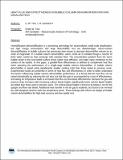Heat Flux and Effectiveness in Bubble Colum Dehumidifiers for HDH Desalination
Author(s)
Tow, Emily W.; Lienhard, John H.
DownloadTIAN13-121.pdf (538.4Kb)
OPEN_ACCESS_POLICY
Open Access Policy
Creative Commons Attribution-Noncommercial-Share Alike
Terms of use
Metadata
Show full item recordAbstract
Humidification-dehumidification is a promising technology for decentralized, small-scale desalination, but high energy consumption and large dehumidifier size are disadvantages. Direct-contact dehumidification in bubble columns has previously been shown to decrease dehumidifier volume by an order of magnitude. In a bubble column dehumidifier, warm, moist air is bubbled though a column of fresh water cooled by heat exchange with seawater feed. The concentration gradient from the warm bubble center to the cool bubble surface drives radial mass diffusion, and water vapor condenses on the surface of the bubble. In this paper, a parallel-flow effectiveness is defined to complement heat flux when assessing the performance of a single-stage bubble column dehumidifier. A bubble column dehumidifier is tested using significantly smaller cooling coils than those tested in previous work. Experimental results are presented in terms of heat flux and effectiveness in order to better understand the factors influencing bubble column dehumidifier performance. It is found that the heat flux can be raised dramatically by reducing the coil area, but that this gain is accompanied by a loss of effectiveness. Increasing air temperature leads to increased heat flux but decreased effectiveness. Because the gas-side pressure drop increases with increasing column liquid height, significantly lower column liquid heights are tested than those used in previous work. The critical liquid height is found to be below 4 cm for the sparger and flow rate tested. Additional heat transfer in the air gap is explored, but found to be minimal for well-designed columns with low temperature pinch. These findings will inform the design of bubble column dehumidifiers for high heat recovery and low capital cost.
Date issued
2013-10Department
Massachusetts Institute of Technology. Department of Mechanical EngineeringJournal
Proceedings of the IDA World Congress on Desalination and Water Reuse 2013
Publisher
International Desalination Association
Citation
Tow, Emily W. and John H. Lienhard. "Heat Flux and Effectiveness in Bubble Colum Dehumidifiers for HDH Desalination." in IDA World Congress on Desalination and Water Reuse: Desalination: a Promise for the future, Oct. 20-25, 2013, Tianjin, China. 14 pp.
Version: Author's final manuscript
Other identifiers
IDAWC/TIAN13 - 121